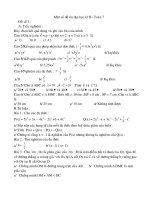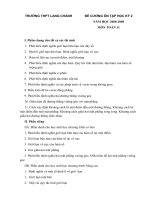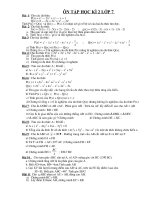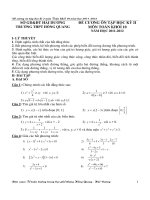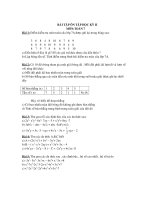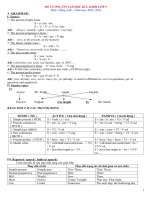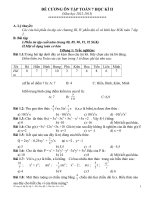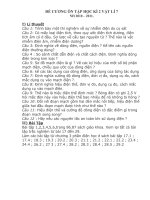Ôn tập học kì 2 khối 7 - Đề 6
Bạn đang xem bản rút gọn của tài liệu. Xem và tải ngay bản đầy đủ của tài liệu tại đây (316.86 KB, 6 trang )
<span class='text_page_counter'>(1)</span>PHÒNG GD & ĐT QUẬN LONG BIÊN TRƯỜNG THCS THANH AM Năm học 2020 – 2021 Đề số 6. ĐỀ ÔN TẬP HỌC KÌ II MÔN TOÁN 7 Thời gian: 90 phút Tuần 40 (28/6 đến 2/7). Bài 1.(2 điểm) Điểm môn Toán của các học sinh lớp 7A được ghi lại trong bảng sau:. 2 3 8 7. 3 8 8 6. 7 7 6 10. 6 8 6 5. 10 7 8 8. 9 9 8 7. 5 6 8 8. 5 8 10 3. a) Dấu hiệu ở đây là gì? Số các giá trị là bao nhiêu? b) Lập bảng tần số và rút ra một vài nhận xét? c) Tính số trung bình cộng (làm tròn đến chữ số thập phân thứ 3) và tìm mốt của dấu hiệu ? 1 Bài 2.(1,5 điểm) Cho đơn thức: A = xy3z 2 .( −12x 2 y 2 ) .(3y 2 z) 9 a) Thu gọn đơn thức A. b) Tìm hệ số, phần biến và bậc của đơn thức A.. Bài 3.(2,5 điểm) Cho hai đa thức. P ( x ) = - 3x 3 + 8x 2 - 3 - 5x + 2x 2 - x và Q ( x ) = x 2 - 2x - 3 - 3x 3 + 8x 2 - 5 a) Thu gọn và sắp xếp đa thức P(x); Q(x) theo lũy thừa giảm dần của biến. b) Tính M(x) = P(x) + Q(x); N(x)= P(x) – Q(x) c) Chứng tỏ rằng đa thức N(x) không có nghiệm. Bài 4.(3,5 điểm) Cho tam giác PQS cân tại P có đường phân giác PI. a) Chứng minh I là trung điểm của QS và PI ⊥ QS. b) Kẻ IH ⊥ PQ ( H PQ ) ;I K ⊥ SP ( K PS) . Chứng minh IH = IK và PI là đường trung trực của HK. c) Trên tia đối tia HI lấy điểm E sao cho HE = HI, trên tia đối tia KI lấy điểm F sao cho KF = KI. Chứng minh PEF cân. d) Chứng minh FE // QS. 1 2. Bài 5.(0,5 điểm) Cho đa thức một biến Q ( x ) = - x 5 + 5x - 4x 4 - x 3 + ax 5 + bx 4 - c + 7x 2 − 5 Tìm các số thực a, b, c biết rằng Q(x) có bậc 4, hệ số cao nhất là 5, hệ số tự do là -10 ?.
<span class='text_page_counter'>(2)</span> TRƯỜNG THCS THANH AM NĂM HỌC 2020- 2021. ÔN TẬP CUỐI HỌC KÌ II MÔN: NGỮ VĂN 7 ĐỀ SỐ 6. PHẦN I: ĐỌC – HIỂU ( 6,0 điểm) Đọc đoạn văn sau và trả lời câu hỏi:. “...Con là một đứa trẻ nhạy cảm. Cứ mỗi lần, vào đêm trước ngày sắp đi chơi xa, con lại háo hức đến nỗi lên giường mà không sao nằm yên được. Nhưng mẹ chỉ dỗ một lát là con đã ngủ. Đêm nay con cũng có niềm háo hức như vậy: Ngày mai con vào lớp Một. Việc chuẩn bị quần áo mới, giày nón mới, cặp sách mới, tập vở mới, mọi thứ đâu đó đã sẵn sàng, khiến con cảm nhận được sự quan trọng của ngày khai trường. Nhưng cũng như một chuyến đi xa, trong lòng con không có mối bận tâm nào khác ngoài chuyện ngày mai thức dậy cho kịp giờ.” ( Trích Ngữ Văn 7- Tập 1) Câu 1. Đoạn văn trên được trích trong văn bản nào? Tác giả là ai? Văn bản được viết theo thể loại nào? Câu 2. Nêu nội dung chính của đọan trích trên. Câu 3. Chỉ rõ và nêu tác dụng của biện pháp tu từ liệt kê trong đoạn văn. Câu 4. Tìm một câu chủ động trong đoạn văn và biến đổi thành câu bị động tương ứng. Câu 5. Nêu tên một văn bản trong chương trình Ngữ Văn THCS cũng nói về tình cảm thiêng liêng giữa cha mẹ với con cái. PHẦN II: ( 4,0 điểm) Đọc văn bản sau và thực hiện các yêu cầu: “ Chuyện kể rằng, có một vòn tròn rất hoàn mĩ. Nó tự hào về thân hình tròn trĩnh đến từng milimet của mình. Thế nhưng một buổi sáng thức dậy, nó thấy mình mất đi ột góc lớn hình tam giác. Buồn bực vòng tròn ta đi tìm mảnh vỡ đó. Vì không còn hàn hảo nên nó lăn rất chậm. Nó bắt đầu ngợi khen những bông hoa dại đang tỏa sắc bên đường, nó vui đùa cùng ánh nắng mặt trời, tâm tình cùng sâu bọ....Một ngày kia, nó tìm được một mảnh hoàn toàn vừa khít và ghép vào. Nó lăn đi và nhận ra mình lăn quá nhanh. Đến nỗi, không kịp nhận ra những bông hoa đang có mỉm cười với nó. Vòng tròn thấy rằng: cuộc sống khác hẳn khi nó lă quá nhanh. Nó dừng lại đặt mảnh vỡ bên đường rôi chầm chậm lăn đi.” ( Theo “Quà tặng cuộc sống”) Câu 1: Xét về cấu tạo, câu văn in đậm trên thuộc kiểu câu nào? Câu 2: Từ câu chuyện trên, em hãy viết đoạn văn nghị luận từ 7- 10 câu với chủ đề: khuyết điểm là một điều tất yếu mà mỗi con người cần chấp nhận để hòa nhập với cộng đồng xã hội.
<span class='text_page_counter'>(3)</span> Thanh Am Lower Secondary School Grade 7. Exercises – Week 6. TEST 6 UNIT 12 I. Choose a word in each line that has different stress pattern. 1. A. megacity B. education C. overcrowded D. malnutrition 2. A. enough B. affect C. narrow D. require 3. A. peaceful B. labour C. diverse D. wealthy 4. A. physician B. criminal C. average D. skyscraper 5. A. homeless B. violence C. skyscraper D. describe II.Find the word which has a different sound in the underlined part. 1. A. density B. countryside C. reason D. list 2. A. sugar B. slum C. cutting D. luck 3. A. fact B. place C. malnutrition D. traffic 4. A. spacious B. delicious C. social D. decision 5. A. decrease B. healthcare C. sea D. disease III.Choose the best one (A, B, C or D) to complete the sentences. 1. The children can read English, ? A. can’t they B. can they C. they can D. they can’t 2. Overcrowded places have a lot of problems, ? A. doesn’t it B. have they C. don’t they D. does they 3. The immigrants will hardly find accommodation in the city, ? A. will it B. won’t it C. will they D. won’t they 4. Disease spreads more quickly in overcrowded areas, ? A. doesn’t it B. is it C. isn’t it D. does it 5. Your brother’s here, ? A. is he B. are he C. isn’t he D. aren’t he 6. When people live in a small lace, life can be very difficult. A. too much B. too many C. a few D. few 7. Living in the country is healthier than that in the city because in the countryside, there is traffic. A. more B. less C. Higher D. fewer 8. Tom didn’t see her, ? A. did Tom B. did he C. do Tom D. does he 9. Children in the slums have more diseases than in wealthy areas. A. those B. Ø C. them D. that 10. People move to the city with the hope that they can get food and better healthcare. A. less B. fewer C. more D. bigger IV.Choose the best one (A, B, C or D) to complete the sentence or replace the underlined word. 1. Don’t leave anything behind, ? A. do you B. don’t you C. will you D. shall we 2. Overpopulation problems both the rich and the poor. A. happen B. affect C. cause D. reduce 3. Rio de Janeiro is a very culturally city. A. different B. same C. diverse D. diversity 4. That isn’t Bill driving, ? A. is it B. isn’t it C. is that D. isn’t that 5. I think in the future cities will be more crowded and the traffic will get . A. good B. well C. worst D. worse 6. The major cause of death for children living in the slums is . A. density B. illiteracy C. immigration D. malnutrition 7. Susan doesn’t like oysters, ? A. did she B. does she C. doesn’t she D. she does 8. Diseases more quickly in overcrowded areas. A. come B. travel C. move D. spread.
<span class='text_page_counter'>(4)</span> 9. It’s very in the city. Some rich people live in large villas, while many poor people live in small slums. A. diverse B. equal C. spacious D. healthy 10. Mary wasn’t angry, ? A. was she B. is she C. wasn’t she D. was Mary 11. In Manila, over 30% of the population lives in . A. poverty B. schooling C. crops D. shortage 12. Some poor people may crime when they need money. A. involve B. arrive C. commit D. accept 13. Your grandfather was a millionaire,_______ ? A. was he B. is he C. wasn’t he D. isn’t she 14. Everyone is ready for the game, ? A. aren’t they B. is there C. is it D. isn’t it 15. The city has to find to homeless people immediately. A. earnings B. systems C. calories D. solutions V.Complete each of the following sentences with a correct question tag. 1. Mr. White is a tailor, ? 2. I think that is an overcrowded bus, ? 3. Mr. Vinh is a teacher, ? 4. Your grandparents don’t prefer living in the city, ? 5. It isn’t ready yet, ? 6. The tourists will never be allowed to visit the slums again, ? 7. I am clever, ? 8. He’s unable to solve that problem alone, ? 9. We must hurry, ? 10. Dai Dong used to be a fishing village with only three thousand people, ? VI.Complete each of the following sentences with a correct question tag. 1. They won’t stop long, ? 2. His brother has lived in Jakarta for more than ten years, ? 3. You asked for mustard, ? 4. These houses cannot provide enough accommodation, ? 5. He speaks too quickly, ? 6. Your sister works for a big foreign company in the city, ? 7. He will arrive soon, ? 8. There were nearly one million people living in this city in 2010, ? 9. The milk may be sour, ? 10. We shouldn’t go to those streets when it turns dark, ? VII. Add question tags to the following statements. 1. Baird didn’t produce the first TV picture before 1920, ? 2. There are many interesting programs tonight, ? 3. Linh didn’t feel confident in her favorite clothes, ? 4. The two cities are not the same in some ways, ? 5. Her listening isn’t excellent, ? 6. Maryam couldn’t stay for longer time, ? 7. My sister has to make this room tidy, ? 8. This poet has mentioned the Ao Dai in poems, ? 9. Lan used to walk past the mosque on her way to primary school, ? 10. Nobody wrote poems yesterday, ? VIII.Read the text carefully, and then answer the question below. Mumbai, which is located in the western coast of India, is the capital of Maharashtra state. It is home to Bollywood, the centre of Hindu movie industry, and the film “Slumdog Millionaire” was based there. Poor people have to live in slums. In the slum, people have to live with many problems. People have to.
<span class='text_page_counter'>(5)</span> go to the toilets in the streets and there are open sewers. Children play among sewage wastes and doctors deal with 4,000 cases of death a day because of lack of hygiene. Next to the open sewers are water pipes which can crack and take in sewage. Dharavi slum is based around this area. There are toxic wastes in the slum including hugely dangerous heavy metals. Dharavi is made of 12 different neighbourhoods and there are no maps or road signs. The further you walk into Dharavi from the edge, the more crowded area becomes. People live in very small slums, often with many members of their extended families. 1. Where are the toilets in the slum? ____________________________________________________________________ 2. Where is Mumbai? ____________________________________________________________________ 3. Is Mumbai famous for the film industry? Why or why not? ____________________________________________________________________ 4. How many neighbourhoods are there in Dharavi? ____________________________________________________________________ 5. What happens to water pipes in Dharavi? ____________________________________________________________________ IX. Read the following passage and answer the questions below. The Philippines has one of the fastest growing populations in Southeast Asia. From having fifty million inhabitants in 1980, the Philippines today is home to around ninety-eight million people with 12 million living in Manila only. Manila, the Philippine capital, is one of the most overpopulated places on earth. There are few other areas where so many people live so closely together: On average there are 66,140 people per square kilometer, but in some slum regions there are as many as 90,000 people living per square kilometer. The world overpopulation is a growing and complex problem. But for the residents of Manila the result is quite simple. They are running out of space. Families live in home-made shacks built in cemeteries, of between railroad tracks or under bridges. They live wherever they can find some space. Even the city’s toxic garbage dumps are home to people who eat, sleep and live surrounded by rotting trash. With so many residents, the city’s resources are strained to the limit. Large parts of Manila’s 12 million residents lack clean drinking water, work, and access to healthcare and education. 1. What is the average density in manila? ____________________________________________________________________ 2. What do most of manila’s residents lack? ____________________________________________________________________ 3. What was the population of the Philippines in 1980? ____________________________________________________________________ 4. Where do homeless people in Manila live? ____________________________________________________________________ 5. How many inhabitants are there in Manila? ___________________________________________________________________________ X.Rewrite the following sentences, beginning as shown, so that the meaning stays the same. 1. Jakarta doesn’t have as many skyscrapers as Shanghai. → Shanghai ............................................................................................................... 2. You forgot to turn off the T.V last night, didn’t you? → You didn’t remember ........................................................................................... ? 3. The countryside doesn’t suffer as much pollution as the city. → The countryside .................................................................................................... 4. I think you should go to work by bike. → Why don’t ............................................................................................................ ? 5. New York has more billionaires than Tokyo. → Tokyo .................................................................................................................. 6. We will plant more trees along this street. → More trees ............................................................................................................ 7. Does overpopulation cause a lot of social problems in this area?.
<span class='text_page_counter'>(6)</span> → Overpopulation .................................................................................................... ? 8. Is pollution the most serious problem? → Pollution is ........................................................................................................... ? 9. A group of foreigners visited the slums last week, didn’t they? → Did........................................................................................................................ ? 10. Mr Lam lived in the country when he was a child. → Mr Lam used .........................................................................................................
<span class='text_page_counter'>(7)</span>
